The gat, a traditional Korean men’s hat, is no longer worn in daily life, but the skills and procedures for making it have survived. A mother and daughter team have devoted themselves to making brims for the hats using bamboo strands, some even thinner than a human hair.
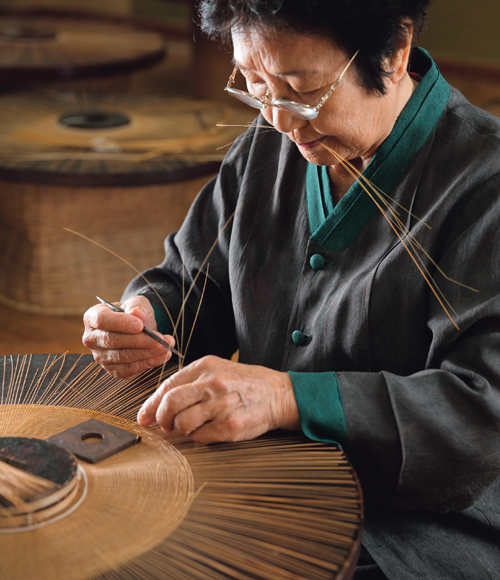
Jang Sun-ja inherited the skills for weaving traditional hat brims from her mother and her mother’s mother, safeguarding the long tradition of Jeju women’s craftsmanship. Her skills were officially recognized with the title of National Intangible Cultural Property in the art of traditional hat brim making in 2000.
With a cylindrical crown and wide brim, the gat was much more than just a hat to Koreans of bygone days. It was a type of formal headwear worn by adult men of high social status, which went with a long overcoat called dopo. When men in mourning for a parent were unable to live at the graveside for a prolonged period, they would wear an extra wide-brimmed hat, called banggat, to express grief and shame so profound that they did not dare to look up at the sky.
Thus, the hat was a symbol of a man’s social standing and philosophy as well as part of his daily life and etiquette. However, when Western clothing became common in Korea from the late 19th century, the traditional hat lost its place in daily life. It now remains an antiquity, found only in period films and dramas. Surprisingly, though, the skills and procedures for fashioning it have been preserved intact to this day.
The gat-making process involves three parts: forming the crown (chongmoja), weaving the brim (yangtae) and assembling the two parts to complete the hat (ipja). The craft for each procedure has been practiced and handed down separately; the division of tasks still remains clear. Therefore, four master artisans share the title of National Intangible Cultural Property No. 4 for traditional hat making: one crown maker, one brim maker and two assemblers. As the hat is not created by a single artisan, no matter how close to perfection each part may be, on its own it is bound to be incomplete.
I recently visited a family whose life has been shaped by this complex craft with a long history. Jang Sun-ja weaves the brims, her skills having been passed down by her mother and her mother’s mother. Three years ago, her own daughter, Yang Geum-mi, took up the reins as fourth-generation artisan.
For Rice on the Table
“Other mothers would pick bracken when in season or gather seafood by the seashore in spring to feed their children, but my mother would weave all day long, day in and day out. She said it would buy rice for our family,” Jang Sun-ja said. “When I went up to her after school, she would not let me come closer, saying that my breath would dampen the bamboo threads.”
Back in the hard times, weaving the traditional hat brims brought a good income for women in five villages around the port of Jeju. Women who didn’t dive to gather seafood would make the brims at the communal workshop. The brims were sent to the mainland, mostly to Tongyeong in South Gyeongsang Province and Yesan in South Chungcheong Province, to be assembled with the horsehair crowns, and the completed hats were sold across the nation. Jang’s mother was widely known on Jeju Island for her excellent skills. Based on her long-standing reputation, she was named a state-recognized “human treasure” in the art of traditional hat brim making in 2000, a position left unfilled for a long time due to a lack of qualified artisans.
“When we were young, my friends and I would get together at a big house in our neighborhood to do the weaving. It was like a game for us,” Jang recalled. “We competed to be the first one to finish each round of the brim. One round meant weaving one strand all the way round back to the starting point. We would take our baskets of materials to the house very early in the morning, come back home for breakfast and then go there again to start working. We did this to save a seat by the window. We didn’t have electricity back then. Weaving the brims is an intricate job and should be done very carefully in a place with good light.”
In her youth, Jang wanted to start her own business. Her father used to tell her not to waste her youthful days working as a day laborer but to find out what she wanted to do and what she would be good at. So, she started a business supplying bamboo stalks to the brim weavers of her hometown. She would leave the island and roam the bamboo fields in Damyang, South Jeolla Province, for over two months at a time looking for good material.
“You had to look for 20-month-old black bamboo stems with long internodes. But they were rare,” she said. “Giant timber bamboos with longer internodes were easy to find, but they are so tough that you might cut your hands working with them. And it’s difficult to get fine strands from them.”
She would rent a house with a spacious yard, where the bamboo stalks were brought in on 10 horse carts. Then she would cut the stalks at the nodes with a hand saw, one by one, taking care that the ends were clean, making it easier to obtain good strands. “Ah, it was such hard work, now that I think about it. But it earned me a lot of money for 11 years,” she recalled.
Jang made still more money by growing tangerines before deciding to inherit her mother’s craft at the age of 43. Her experience in the bamboo trade was valuable since producing fine bamboo strands is a critical part of the craft. It is done by boiling the culms in caustic soda and ash, drying them for two days, making tiny cuts on the dried culms and splitting them into thin strips. From a 1-centimeter-wide strip, Jang obtains 50 to 70 strands in 18 different thicknesses, some thinner than a human hair.
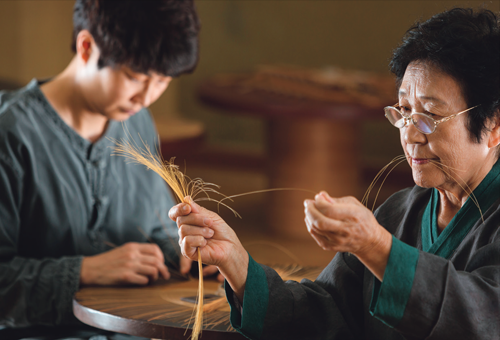
Jang Sun-ja and her daughter Yang Geum-mi, who is taking over her mother’s job, make bamboo strands together. Bamboo culms are boiled in caustic soda and ash, dried for two days, and split into strips 1 centimeter wide. Each strip is then divided into 50 to 70 strands.
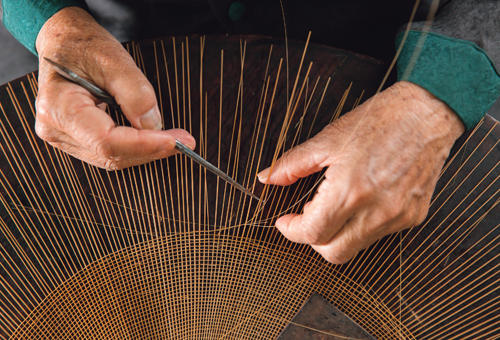
To weave the brim, the warp strands are arranged circularly on a round wooden plate, and four wefts are passed through them, starting from the center and moving toward the edges. The threads get thicker toward the edges to maintain an even texture and density throughout the surface.
Thinner than Hair
“The cuts made on the culms are so tiny that I rely on my fingertips rather than my eyes. It leaves my hands rough and sore. I’m hardly aware of this while doing the work, because I focus completely on the tips of the strips,” said Jang.
Her nails warped and thickened, and her fingertips worn down, she weaves the bamboo strands to make the hat brims. The work itself looks rather simple — passing four wefts through the warps arranged circularly on a round wooden plate — but it requires a quick eye to judge the space between the threads and decide the thickness of the wefts for each round. The thinnest strands are used for the inner rim closest to the crown, and thicker ones for the looser outer edges. Keeping balance is essential. To complete the brim of a single hat, some 300 to 500 strands of 18 different thicknesses are used in a way that maintains an even texture across the surface.
Jang’s daughter chimed in, explaining, “A graceful and dignified hat is one with a broad brim, evenly textured with tightly woven bamboo threads.” The beauty and grace of a hat shines through when the sunlight on the finely-woven, translucent brim casts a soft shadow over the wearer’s face.
“The final product is completed by joining the bamboo brim to the horsehair crown,” the daughter added. “Sometimes, bamboo or silk thread, as well as silk lining, is used in the process. I believe few other hats in the world are made with such delicate craftsmanship. The traditional hats featured in films and other media are mostly replicas, entirely different from the authentic handcrafted ones.”
Her nails warped and thickened, and her fingertips worn down, she weaves the bamboo strands to make the hat brims… The thinnest threads are used for the inner rim closest to the crown, and thicker ones for the looser outer edges.
A Lifelong Goal
During the conversation, a topic that kept turning up was the exhibition hall that Jang helped to build in 2009 to showcase the art of traditional hat making.
“At first, the provincial government decided that the craft of producing bamboo hat brims was not worthy of being recognized as cultural property, so I turned to the Cultural Heritage Administration and received a grant of 890 million won,” she said. “I sold my tangerine orchard to buy land for an exhibition hall at a location that met all the administrative requirements, then donated the land to the provincial government. I endured so much hardship and unjust treatment to build this hall.”
In addition to her money, Jang poured into the exhibition hall her time, memories and beliefs.
She went on, “When I was younger, I was toying with the idea of becoming the village head or running for a seat in the provincial council. But then the Cultural Heritage Administration urged my mother to appoint a successor. I wasn’t sure that I wanted to do it, because it’s such a lonely job. I thought about it and in the end agreed, because I wanted to do something worthwhile. I bided my time for more than 10 years, producing a steady flow of works. At 62, when my skills were officially recognized, I made up my mind to build a museum to leave something behind. That’s when I started to save money.”
The octogenarian artisan who hopes to sum up her life in the museum has her daughter at her side. Yang Geum-mi studied visual design at college and worked as a designer in Seoul before she quit three years ago and returned home, changing the course of her life after her mother’s persistent persuasion.
“Not once in my life had I thought of doing this work,” Yang said. “I vaguely acknowledged that one of us children would have to take it on, but I didn’t think it would be me.” All the same, she was chosen, which she thinks was due to her being single and having more time on her hands. She feels responsible for preserving the craft, and is doing her best to that end, but finds it hard to wholly dedicate herself to the work while making a living by farming tangerines. “The demand for the hats? Only a handful, I must say. And it takes three artisans to produce one piece, so it typically costs more than 10 million won,” she said.
In spite of occasional frustrations, Yang is well aware of her role as fourth-generation bearer of the tradition. Currently, she is looking for ways to modernize the brim-making techniques and materials, conducting research to strengthen the brittle bamboo strands to commercialize them. With a thirst for perfection, she also hopes to learn the other crafts to make not just the brim but a complete Jeju gat with her own hands.
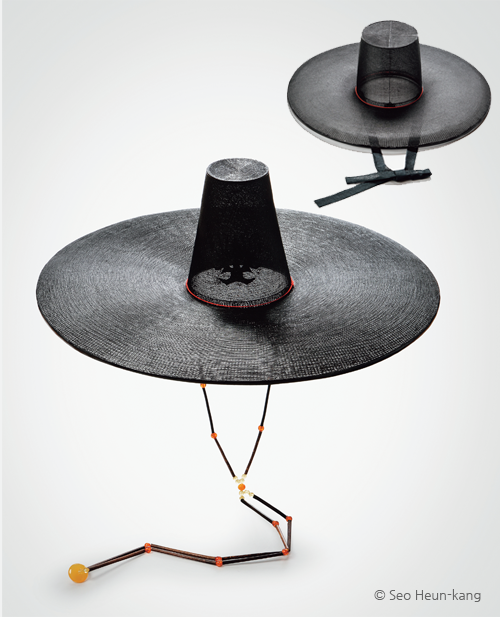
Hats with a horsehair crown and bamboo brim, called gat, were worn by adult men of the Joseon period when they went out. The shapes and details of the hat underwent changes with time, and the straps tied under the chin, adorned with precious stones like amber and coral, served a decorative purpose.
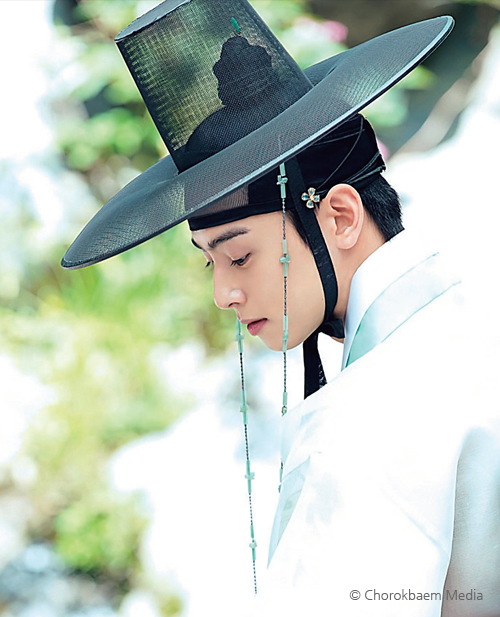
The hat is an important element of men’s costume in period dramas, adding beauty and elegance to the attire. The exquisitely woven brim casts a soft shadow over the wearer’s face, creating a touch of dignity.
Safeguarding Tradition
Listening to her talk, Jang often chipped in with praise of her daughter’s character and abilities. But then she provoked her by saying that everything would be easier for her daughter because she had paved the way. Yang lamented, jokingly, that her mother takes her sacrifice for granted. While acknowledging that it might be a sacrifice, Jang retorted that in her eyes it was a piece of cake.
Jang grew serious again when she said that, if her daughter worked for a company, she would eventually have to retire. This craft, however, will reward her with the official cultural heritage designation and give her life direction and meaning. She went on that she was proud of herself for calling her daughter home to take over the job. “I can die smiling, knowing that she will carry on the legacy,” she said.
Offering a tour around the exhibition hall, Jang angled for a response, asking if I thought it was worth visiting. Giving her my assurances, I thought about one person’s desire and will to pour everything into preserving tradition against the tide of time and the responsibility accepted by another to pass it on to posterity.